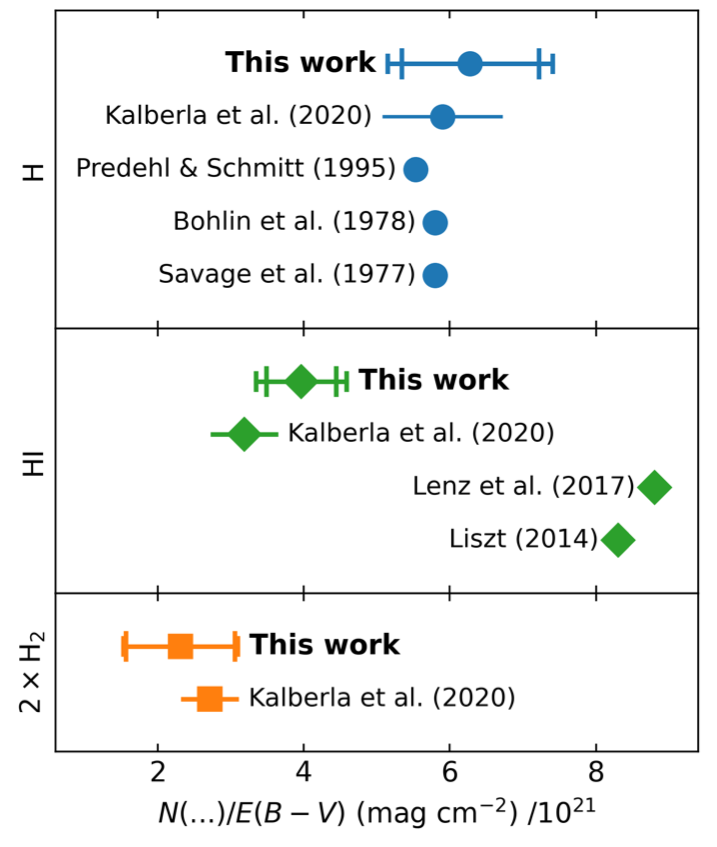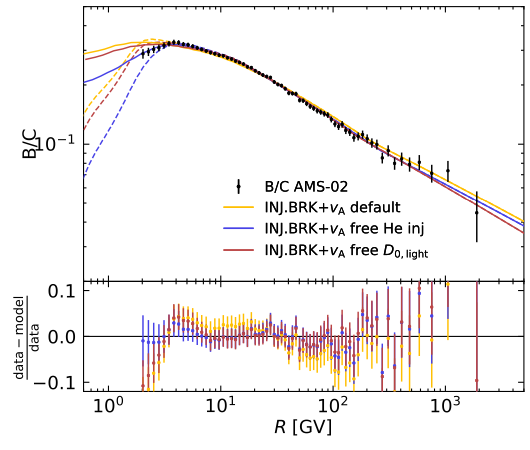My research expertise is associated to the indirect search of Dark Matter (DM) with Cosmic Rays (CRs) and gamma-rays. Inevitable connected to indirect probes of particle DM is a precise under- standing of the expected astrophysical background. Therefore, in practice improving and modelling of Galactic and extragalactic sources and the propagation of CRs and gamma-rays is an important part of my research.
Unveiling the nature of DM poses one of fundamental open questions in contemporary physics. Despite various hints and anomalies in different observables no clear non-gravitational evidence for DM has been established so far. However, a consistent model of DM is expected to leave characteristic signatures in different observables. By exploiting the complementarity of these different observables, we can obtain a better understanding of the nature of DM which can either lead to improved constraints or, eventually, point to the properties of DM. The baryonic matter in our Universe is described by the Standard Model of particle physics (SM). An apparent reasoning for the nature of DM is to explain it by a yet undiscovered elementary particle which could be weakly coupled to the SM. Theoretically motivated models of DM range from extremely light particles, like fuzzy DM (∼ 10−22 eV) or axions (∼ 10−5 eV), to primordial black holes (up to 1065 eV). One of the most attractive DM candidates is a Weakly Interacting Massive Particle (WIMP) which typically has a DM masses between 10 GeV and 100 TeV. The appeal of this candidate is that a WIMP annihilation cross section at the scale of SM weak cross sections would automatically lead to the freeze-out of DM in the early Universe and give the correct DM relic density observed today.
The search for such a DM particle is typically structured into three different strategies: direct, indirect, and collider-based searches. In the first case, the idea is to investigate the possibility of a direct interaction between a DM particle and a nucleus. Various underground experiments try to measure the recoil energy of nuclei due to the scattering off DM. The second option is to search for indirect signatures of DM in astrophysical observables. The hypothesis is that DM can either decay or self-annihilate into SM final states. In both cases one expects characteristic signatures in gamma rays, CRs, and neutrinos. Finally, the DM particles might be produced directly in collider experiments, as for example at the Large Hadron Collider (LHC). Closely related to the production of DM at colliders is the question for the DM production in the early Universe.
The search for DM is an interdisciplinary effort, an unambiguous answer concerning the nature of DM can only be achieved by combining the information of different observations from particle physics, astrophysics, and cosmology.
In the last decade, spaced-based experiments like PAMELA and AMS-02 provided flux measure- ments of CR leptons and nuclei with unprecedented precision in the energy range between 1 GeV and a few TeV. For many species, the measurement accuracy is pushed to the level of a few percent. The most precise measurement of CR antiprotons is provided by AMS-02 with a precision below 5% between 2 GeV and 100 GeV. On the one hand, the precise data offers the unique opportunity to improve our knowledge and modelling of CR sources and propagation in the Galaxy, also allowing to investigate unconventional scenarios like non-power-law and non-isotropic diffusion. On the other hand, systematic uncertainties in the modelling become substantially important since they poten- tially bias our conclusions. Systematics arise from the scarcity of precise secondary production cross sections measurement, uncertainties in the gas densities and composition of the interstellar medium (ISM), and our limited understanding of solar modulation.
Furthermore, due to the achieved data precision statistically meaningful conclusions should consider the correlations of the systematic un- certainties in the CR measurements which are typically not provided by the experiments and rather have to be modelled. CR antiprotons are a promising channel to search for DM in CRs. The as- trophysical component comes form the interaction of of primary CRs with the ISM, namely, it is purely secondary, which leads to a suppression of the astrophysical antiprotons and consequently
a good signal-to-background ratio. In the last years, it has been established that the antiproton fluxes measured by PAMELA and AMS-02 are dominated by secondaries at all energies. However, a sub-dominant primary DM signal with a characteristic energy shape could be hidden in the precise CR data. I have worked on the secondary antiproton production cross section with the focus at: i) improving the available cross section parametrizations by exploiting newly available cross section measurement by the high-energy experiments NA61 and LHCb, ii) providing guidelines for future cross section measurements concerning the most relevant parameter space, and iii) investigating the potential of cross section measurement by the future collaboration COMPASS++/AMBER in the proton-proton and proton-helium interactions.
The antiproton production cross section and its uncertainty proves to be a very important ingredient to scrutinize the evidence for a potential DM hint in CR antiprotons which points to a self-annihilating DM candidate into generic SM final states with DM masses between 40 GeV and 150 GeV. This hint was discussed controversially in the past few years. In our analysis the cross-section uncertain- ties reduce the significance of the DM hint below 3σ. However, an improved understanding of CR propagation might change the situation. Therefore, it is interesting to explore the compatibility of this hint with other observations, in particular, from gamma-rays, for which there are strong limits on DM annihilation from dwarf spheroidal galaxies and there is an excess observed at the Galactic center. We showed as an example that the results can be interpreted in the framework of the Higgs portal model. Besides the DM hint, antiprotons provide a powerful tool to constrain the annihilation cross section of DM heavier than 200 GeV. We showed that in order to obtain robust DM limits it is important to marginalize over CR propagation uncertainties. In the context of three specific scenarios of Minimal DM models we have demonstrated the important complementarity between our CR limits and limits from gamma-rays.
A complemental strategy to search for DM in CRs is to look for low-energetic antinuclei. Below 1 GeV, the production of secondary antinuclei is strongly suppressed by kinematics. Already the detection of a single antideuteron or antihelium particle at those energies by AMS-02 or the future experiment GAPS would point to a DM origin. We have explored the prospects of a detectable signal from the DM hint in CR antiprotons which corresponds to the largest possible DM signal in antinuclei compatible with CR antiprotons. Furthermore, we have updated the predictions of the sec- ondary fluxes which are below current sensitivities of AMS-02 and expected the expected sensitivity of GAPS.
The Fermi-LAT experiment acquired more than ten years of precise gamma-ray data allowing to study sources and emission over the whole sky. The resulting gamma-ray map can be composed in three different components: Galactic and extragalactic point sources, Galactic diffuse emission caused by the interaction of CRs with the interstellar gas and radiation field, and the Unresolved Gamma-Ray Background (UGRB). The resolved extragalactic sources are dominantly blazars. However, at smaller photon fluxes, S, below the threshold to detect individual sources, further astrophysical objects, like misaligned active galactic nuclei and star-forming galaxies, and, depending on its properties, DM are expected to contribute to the photon flux. There are two established tools to investigate point sources below the flux threshold. First, the photon-count statistics (see also 1pPDF or non-Poissonian template fitting) can be used to measure the source-count distribution, dN/dS, up to about one order of magnitude below the flux threshold. Second, the measurement of angular correlations constrains the integral of S2 dN/dS below the flux threshold. We use these two techniques to constrain the blazar luminosity function in the unresolved regime. The blazar luminosity function is an important quantity when modelling cross-correlations of the gamma-ray sky with other observables. In particular, the cross-correlation with gravitational tracers of matter in the Universe has been shown to be a compelling method to search for DM signatures in the UGRB. It will be interesting to investigate the impact of a better blazar luminosity function on these analyses.

